How Experts Do Personalized Product Recommendations (And Why You Should Uninstall your Shopify Upsell Apps Right Now)
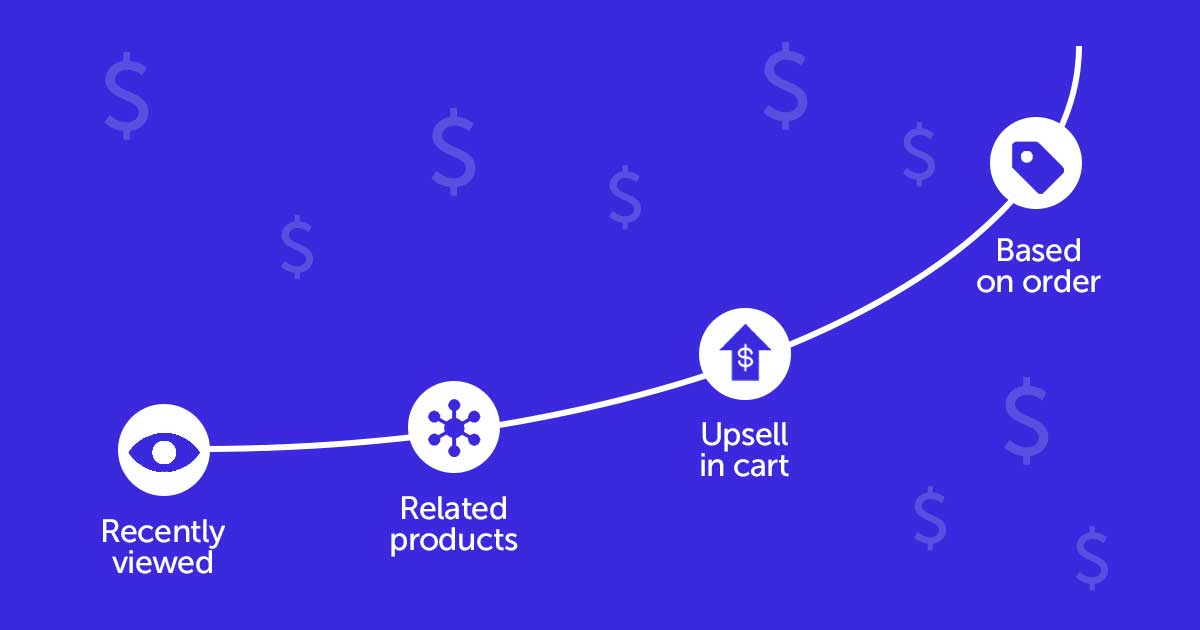
Going with the right product recommendation strategy that supports your growth goals can be challenging – especially if you’re not a personalization expert and you think quick revenue wins will actually help you.
Our customers and agency partners tell us, most eCommerce teams are doing some sort of product recommendations or at least considering it for the future. You might think that means choosing an Upsell or Cross sell app and moving on – I’m here to share why that tactic will eventually stunt your growth.
So, an effective recommendation solution must provide guidance and the decision-making logic for choosing the right product recommendation experiences.
Additionally, the best solutions should also minimize the downside of choosing the wrong recommendation strategies. We’re talking about the potential loss of revenue or missing the mark when it comes to creating an engaging product discovery experience.
Start by planning your product recommendation strategy for Customer Lifetime Value
It’s your game plan, designed to maximize a specific business objective. For example, to show new visitors’ products that match interests of people grouped by channels, devices, and time of the day.
HiConversion Recommend powered by Amazon Personalize combines grouping of product recommendations based on different types of strategies together with performance indicators – illustrating the effectiveness of those strategies individually or as a group.
It’s as simple as choosing an appropriate strategy based on your business objective – we’re providing three pillars of recommendation strategies, which map directly to the established set-up of your eCommerce operation:
- Product Merchandising – how you display products and offers on your site.
- Store Experience – how you manage your overall online shopping experience.
- Customer Lifecycle – how you serve visitors based on where they are in their purchase journey.
And, since these strategies are not mutually exclusive, you can use different recommendations across multiple strategies. In the next section, I’ll explore each of the 3 strategy groups and provide recommendation examples.
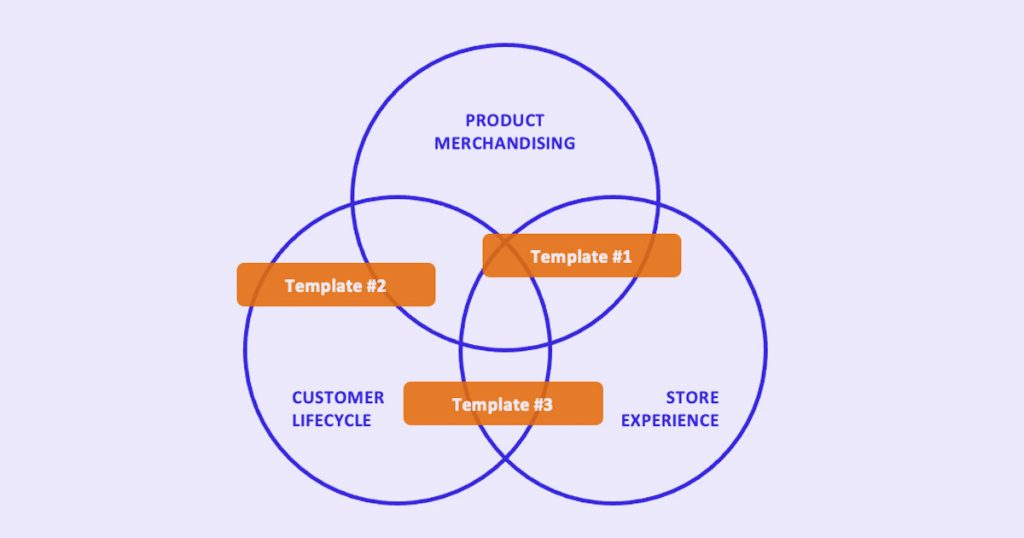
But first: How to quickly check if your existing Shopify Upsell app is hurting your growth.
There’s a big difference between short-term revenue boosts and long-term growth. The goal of any good product recommendation strategy is not to simply improve a few metrics like conversion rate or average order value temporarily.
This is something called the revenue boost illusion – when a merchant experiences a few gains after testing and expects them to stick around permanently. In reality, these improvements typically only last a short period of time unless they are changed or adjusted.
Your customers’ behavior is constantly changing, so why shouldn’t your shopping experience need to keep up? It surely does.
Here’s how optimization guru, Wouter van der Heijden, defines Customer Lifetime Value (CLV):
“CLV is the Key Performance Indicator that determines the value of a customer. This determines how much you can spend to recruit customers on the long term, keeping in mind the return purchases of the customer.”
Yes, eCommerce entropy is a thing – without continuous testing and analysis, sites inevitably decline into disorder.
So, go into your existing upsell or personalization app dashboard now, and check the revenue generated from your upsell app. If it is working, you should see exponential new revenue growth. If not, well…
Here’s what exponential revenue growth looks like on Shopify with HiConversion.
Product Merchandising Strategies
This set of strategies leverage what we call ‘Product centric’ recommendations. It’s comparable to how you might merchandise in a conventional brick and mortar retail store.
Merchandising is defined by Practical Ecommerce as “the art and science of displaying products or offers on a website with the goal of increasing sales.”
HiConversion Recommend’s merchandising strategies connect the advanced technology behind personalized recommendations to your daily operations. What this really means is you can now benefit from the power of machine learning without needing to fully understand it.
The main objective of eCommerce merchandising, whether you have a small or extensive product catalog, is guiding your visitors through the buying journey. And when it comes to choosing the type of product merchandising recommendations you could use, there are various sub-categories they can be grouped into:
- Browsing history based
- Similarity based
- Category based
- Product based
- Session based
So, the act of merchandising is used to ensure visitors get a consistent, on-brand experience; no matter how they arrive on your site or navigate around it.
3 examples of product merchandising recommendations you can try today, inspired by Amazon:
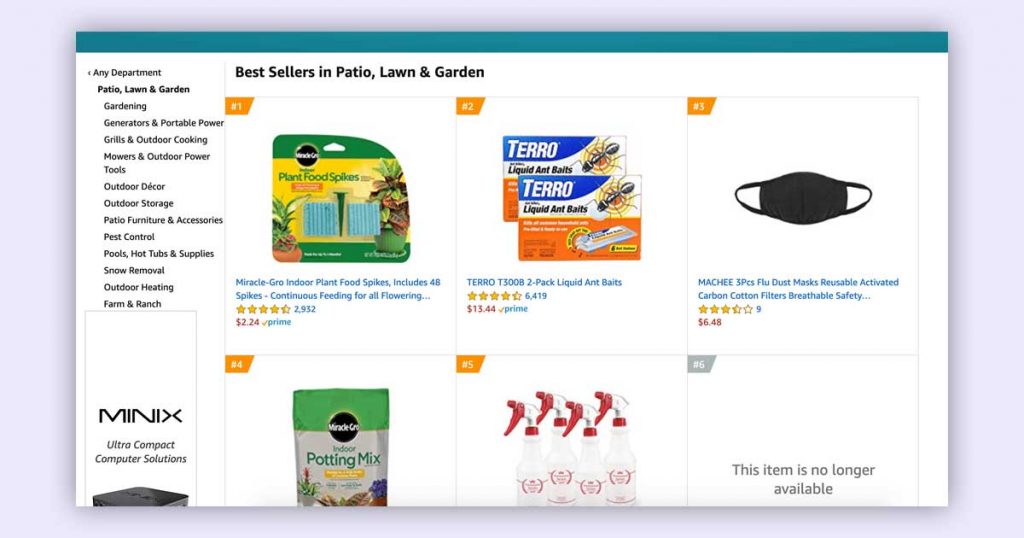
Best Sellers
This ranks products by revenue total. Suggested locations are Homepage and Category pages, in the top section of the page. Typically displays your most profitable products.
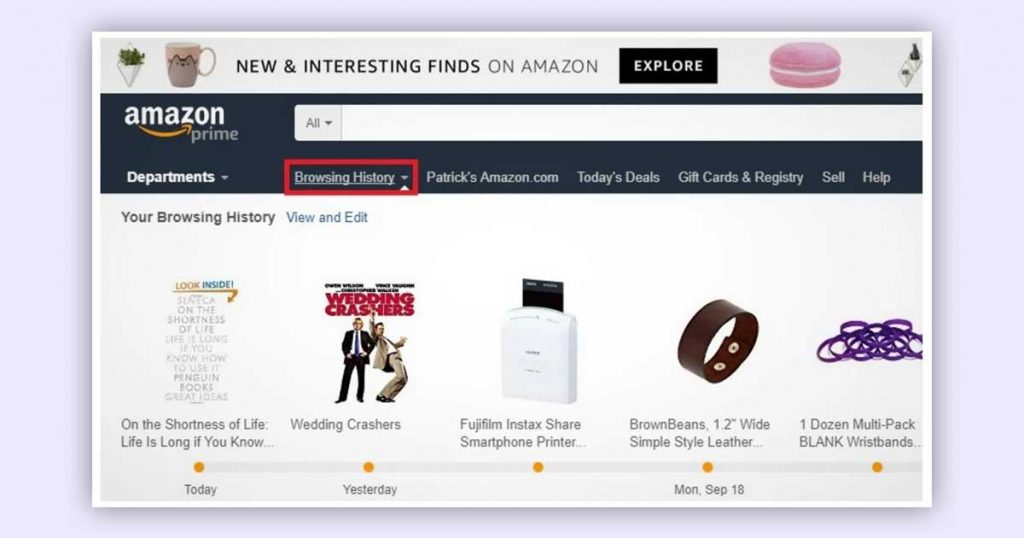
Recently Viewed Products
This strategy uses product lists from visitor browsing history. It will not display if empty and typically placed site-wide, just above the site footer. This widget makes it convenient to go back to previously viewed products.
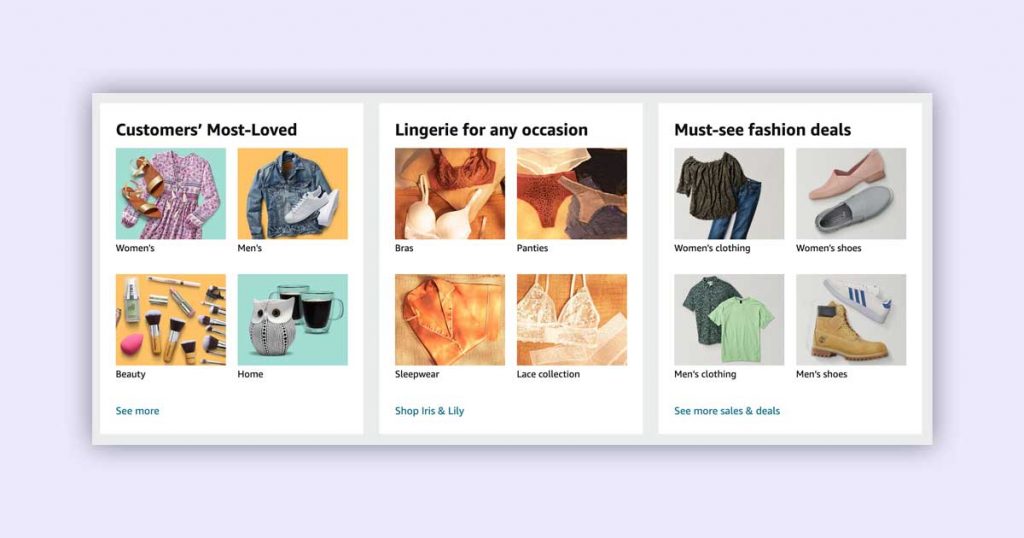
Popular Categories
Displays top product categories. Category listing is based on ranking categories on the basis of the total revenue. It is best placed in the middle section of the home page.
Store Experience Strategies
These strategies group ‘brand centric’ recommendations. Think of it as applicable to visual merchandising in your online store.
As a consumer and eCommerce professional, you’re no doubt aware of retail-store visual merchandising – it’s used to engage customers from the minute they walk in, to the moment they leave.
And numerous merchandising tactics have become standards over the years, used to captivate the senses and create memorable shopping experiences.
Store colors, product display, space utilization, signage, innovative layout, or even the checkout flow are just a few methods of visual merchandising. All with the goal of strengthening brand identity, fostering loyalty, driving sales, and generating repeat business.
When it comes to online-store visual merchandising, the concepts are comparable to retail store merchandising but with one big difference – traditional retailers are optimizing the physical store experience for the average shopper.
Online retailers, in contrast, can tailor the shopping experience for many different types of visitors – as they interact with the brand – increasing the impact of efforts.
However, that advantage also comes with the cost of added complexity and an increased risk of poor results.
3 examples of store experience recommendations you can try today:

Customers Who Viewed This Product Also Viewed
List based on collaborative filtering of visitor sessions with product views. Placed on product detail pages (PDPs) at the top below product description.
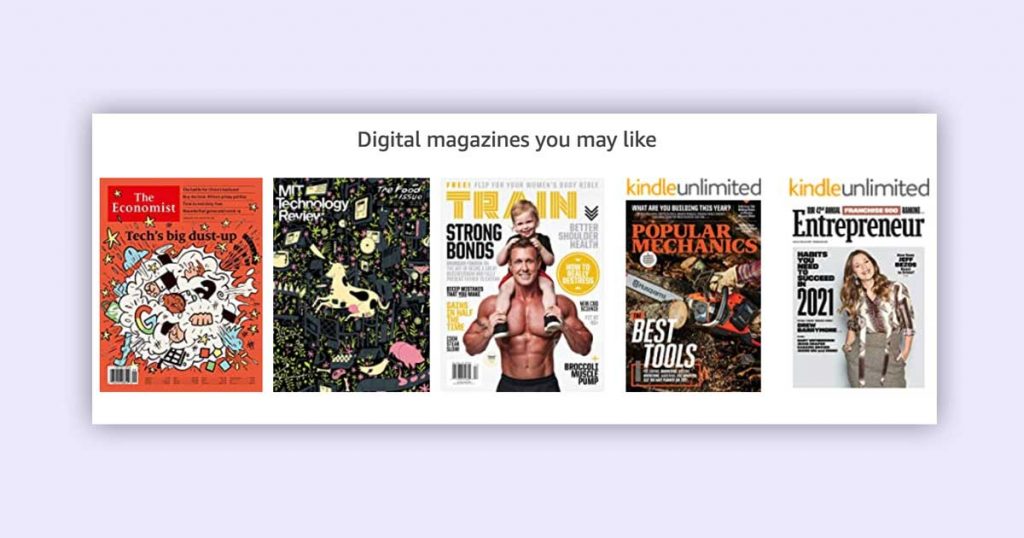
You may Like
Uses session-based algorithm and visitor events to generate recommendations. Placed on product detail pages (PDPs) at the top below product description.
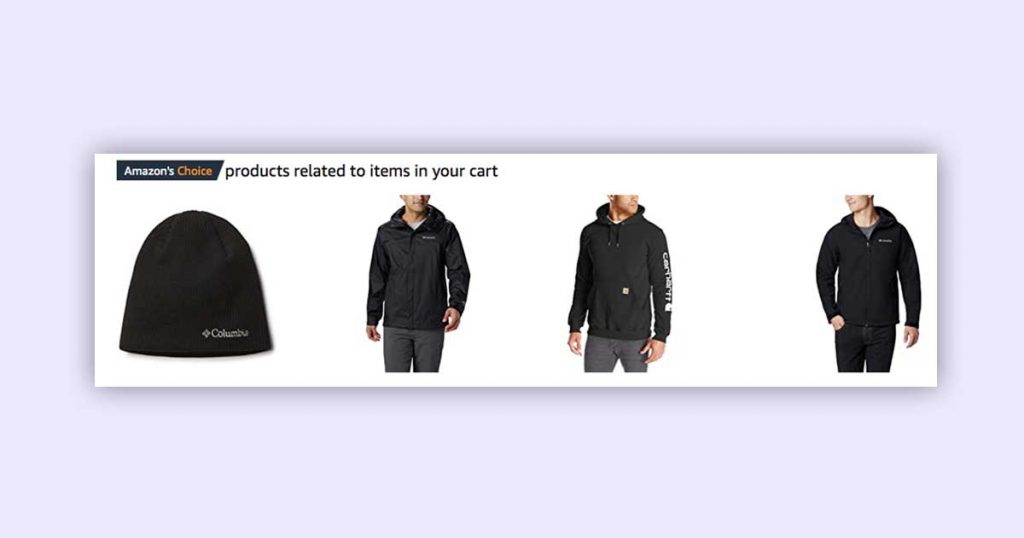
Related Items in Your Cart
Presented to all visitors after they add product to the cart. Product list is based on collaborative filtering of items added to cart by all visitors. Suggested placement is in the cart/mini-cart below the list of items in the cart. This recommendation is used to upsell based on items already added to the online shopping cart.
Customer Lifecycle Strategies
These are ‘Visitor Centric’ recommendations – leveraging the power of ‘session-based’ machine learning. In other words, adapting to visitor preferences in real-time across all phases of the customer lifecycle.
Inspired by the new eCommerce sales framework – ‘Customer Lifecycle Model’ – introduced to surround visitors with the right brand experiences throughout the different phases of the purchase cycle.
This differs from the conventional ‘sales funnel’, which assumes all shoppers follow the exact same path.

Now, at this point, it is good to understand even the most advanced conventional personalization solutions are only making recommendations based on a relationship between products and a visitor.
Mapping visitor behaviors to the different stages of the Customer Lifecycle are important, because it helps you determine which recommendations might be most impactful.
The 4 phases of Customer Lifecycle are:
Discover – Visitors arriving to an unfamiliar site and being exposed to new brand and product offerings.
Explore – Visitors browsing the items available by collections, brand, price, etc.
Buy – Visitors select an item and completes purchase in the most convenient way at zero moment of truth
Engage – Staying connected with the brand, company, and/or peers about the product via numerous channels
For example: if a visitor is new to your site – classified as in the ‘Discover’ phase – it’s best to show them your ‘Bestsellers’ rather than ‘Products They Might Also Like’.
3 Customer Lifecycle focused product recommendations to try:
- Popular in Your Area (Discover). Ranks products by various metrics filtered by metro area. Suggested page locations are home and category in the top section of the page.
- Deals in ‘Category’ (Explore). Determines which category of products is generating the most revenue from products on sale, then generates the list of top-selling items. Filtered by items on sale. Suggested page location is home in the middle of the page.
- Inspired by Past Purchases (Engage). Uses purchase history to generate an extended list of top-selling products, then ordered to match visitor preferences.
Lessons in differentiation for Shopify brands by Amazon Personalize
Do you ever find yourself wondering why Amazon leaped so far ahead over the years?
The answer people give most of the time is “they have the best customer experience.”
While this may be true, things get interesting when you dig deeper and ask about what exactly makes the Amazon shopping experience so great.
I’m willing to bet most of the time they’ll say “it’s easy to find what I’m looking for.”
Now we’re getting somewhere…
Lesson #1: Know what your customers want and make it effortless to find on your site.
Ideally, the product should find them – not the other way around. Now that’s truly effortless.
Another critical but often overlooked step is bringing them back after the first purchase.
“There needs to be a strong program in place to quickly convert the first-time buyer to a second order, and almost nobody puts in the effort to do this.” – Kevin Hillstrom
Building customer loyalty isn’t easy, and the initial purchase is just the foundation.
Lesson #2: Turn a new customer into a repeat customer as soon as possible.
What do both of these lessons have in common? They are achieved by Amazon through personalized product recommendations – a strategy that started as a simple experiment over 20 years ago and has since evolved into arguably their biggest digital differentiator.
Rather than spending resources on quick wins that may eventually turn into losses, build a shopping experience that caters to the needs of the individual.



